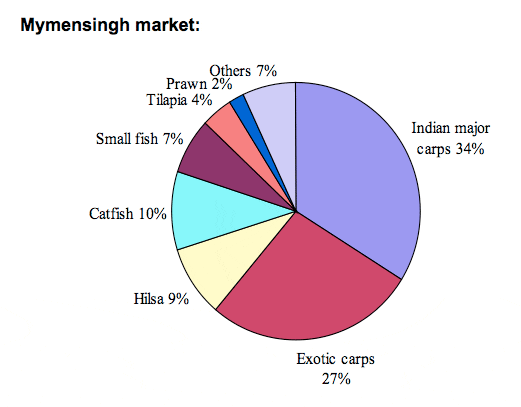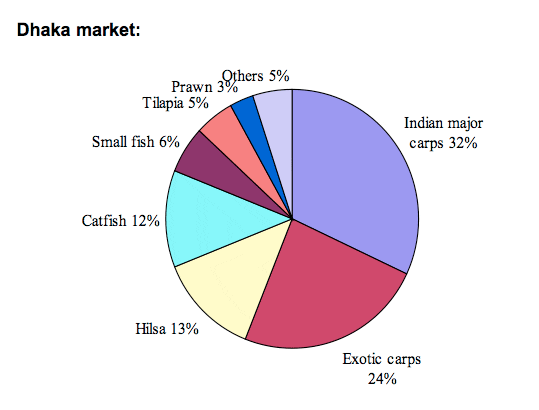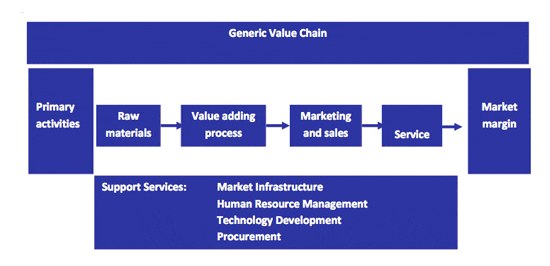Harvesting and marketing of fish
Harvesting of low-valued fish starts as soon as fish reach marketable size. The peak fish harvesting season is from August to December. Most farmers harvest fish by themselves although a few large farmers depend on commercial harvesters. Normally, fish are harvested at very early hours in the morning. Most farmers practice partial harvesting of larger fish which allows smaller fish to grow, while a few farmers practice total harvest. Farmers harvest fish by using cast nets and seine nets. Harvested fish are cleaned with tube- well water and kept in aluminium and plastic containers or bamboo baskets until they are sold.
Almost all produced low-valued fish is marketed internally for domestic consumption. Depending on the transaction volumes, farmers sell their fish to the local agents or suppliers. Vans and rickshaws (i.e. pedal tricycle) are commonly used to transport fish from remote villages to the main road side which takes 30 minutes to an hour, depending on distance. According to the survey, 65 per cent of fish are transported to the capital city of Dhaka, around 75-100 km south from the fish producing areas. The rest (35 per cent) of the fish are transported to nearby Mymensingh town markets (10-25 km north from the fish producing areas). The farm-gate prices of fish depend on their species, quality, size and weight, supply and demand, and seasonality. The average farm-gate price of fish was estimated at US$ 0.70 per kg, varied between US$ 0.59 and 0.81 per kg (Table 1).
A number of constraints were reported by farmers in marketing of fish, including poor road and transport facilities, higher transport costs, inadequate knowledge on marketing systems, low market price and exploitation by intermediaries. Farmers are in a particularly weak position (i.e. no bargaining power on price) in relation to intermediaries of fish marketing. Farmers often feel exploitation by the intermediaries as the prices they received for fish do not adequately reflect the prices paid by the consumers.
| Species | Product share (%) | Price (US$/kg)* | Total average price US$/kg) |
|---|---|---|---|
| Bighead carp | 5 | 0.76 | |
| Common Carp | 12 | 0.70 | |
| Grass Carp | 8 | 0.81 | 0.70 |
| Silver Carp | 35 | 0.66 | |
| Pangas | 40 | 0.59 | |
|
* Price estimated for 1 kg size of fish; US$1 = Tk 68 in February 2009.
|
|||
Table 2: Average prices (US$/kg) of low-valued cultured fi sh in retail markets
| Species | Mymensingh market | Dhaka market | Total average |
|---|---|---|---|
| Bighead carp | 1.34 | 1.56 | 1.45 |
| Common carp | 1.27 | 1.51 | 1.39 |
| Grass carp | 1.32 | 1.59 | 1.46 |
| Silver carp | 1.24 | 1.50 | 1.37 |
| Pangas | 0.97 | 1.18 | 1.07 |
| Average | 1.23 | 1.47 | 1.35 |
|
Price estimated for 1 kg size of fish.
|
|||
Figure 1. Low-valued cultured fi sh marketing systems from producers to consumers.

Fish marketing systems
The fish marketing system is traditional but plays a vital role in connecting the farmers and consumers, thus contributing significantly in the value adding process. A large number of poor people find employment in the fish marketing chain as farmers, local agents, suppliers, transporters, traders and day labourers including women and children. Farmers are the primary producers in the fish marketing systems. With a few exceptions, farmers never directly communicate with consumers. The market chain from farmers to consumers encompasses mainly primary, secondary and retail markets, involving local agents, suppliers, wholesalers and retailers (Figure 1). The demand for fish is high in markets but supply is limited, and a strong network has developed with intermediaries and traders. Communication between the suppliers and wholesalers is generally good and takes place by mobile phones. Suppliers are tied to a limited number of wholesalers. Suppliers commonly use trucks, buses, pickups and taxis to transport fish to wholesale markets in Mymensingh and Dhaka, which takes 1-4 hours depending on distance and mode of transportation.
As soon as the suppliers land fish in the wholesale market, the wholesalers take care of landing, handling and auctioning by species and size-groups. A number of day labourers work with the wholesalers to perform post-landing tasks that include cleaning, sorting, grading and icing of fish. Normally, the auction sale is made by heaps and wholesalers follow the incremental price system. It is the most competitive form of auctioning and ensures better prices. Auctioneers get commission at different rates of the sale proceeds, normally 2-5 per cent of the auction price, for their services and costs involved. Auctioneers appointed by wholesalers, call out bid loudly in the presence of buyers (i.e. retailers). Retailers often take temporary credit from wholesalers, buying fish one day and paying one or two days later. Retail sales are made at stalls in fish markets. Fish are traded whole, gutted and fresh without processing, apart from sorting and icing.
Fish trading in retail markets
According to the survey, a typical retailer in Dhaka markets sold an average of 34 kg/day low-valued fish during the peak season from August to December, while in Mymensingh markets sold an average of 25 kg/day. The supply of fish in Dhaka markets was higher due to the higher number of traders and consumers associated. On the other hand, the supply of fish in Mymensingh markets was lower due to the lower number of consumers involved. Nevertheless, it was estimated that 27 per cent of market share was exotic carps in Mymensingh markets while it was 24 per cent in Dhaka markets (Figure 2). Among catfish, 70-80 per cent comprises pangas in market share. Low-valued cultured fish are sold according to species. The retail market prices of fish depend on quality, size and weight, season, supply and demand, and market infrastructure. The average price of fish from traders to consumers was estimated to be US$1.35 per kg, ranging from US$0.97 to 1.59 per kg (Table 4). Overall, the prices of fish were considerably higher in Dhaka markets than Mymensingh due to a larger concentration of consumers and superior family incomes.
The consumption of low-valued cultured fish at household level has been increasing. It was reported by the traders that consumers usually prefer fresh fish without ice. In general, the high income groups (i.e. high officials and rich businessmen) buy large fish, and the middle-class is able to afford medium- sized and small fish. The large segments of poor people also buy small fish. Nevertheless, most consumers preferred larger fish due to taste, but normally purchased smaller because of lower market price.
Figure 2. Market shares of different groups of fi sh in retail markets.


Value chain analysis
The value chain describes the full range of activities which are required to bring a product or service from conception, through the different phases of production, delivery to final consumers (Kaplinsky and Morris, 2000; Jacinto, 2004). In fish marketing systems, value chain is a structure of physical, economic and social transactions between individuals and organisations engaged in raw material transformation into end products (Figure 3). Flows of fish products and money are exchanged through value adding transactions driven by profit and allocation.
In marketing of low-valued cultured fish, farmers can not earn a good profit because they have a limited access to market and they do not have enough knowledge on where to sell for their products. It was calculated that farmers received an average 52 per cent of the retail price which is unduly low. The farm- gate prices of fish are low due to exploit by intermediaries. The intermediaries avail the opportunity and exploit both the farmers at the farm-gate level and consumers at the retail point. Farmers profit margins get reduce with the increase in number of intermediaries in the fish marketing channel. This implies that prices go up with increasing number of transactions in the fish marketing channel. Presence of intermediaries in the marketing channel mainly due to lack of government control over the trade.
For value chain analysis of low-valued cultured fish marketing, variables like marketing costs and margins, number of intermediaries in the marketing channel, distance between primary and retail markets, and consumers’ behaviours on price are important factors. Amongst the intermediaries in the fish marketing channel, the highest average marketing margin per kilogram of fish was received by the wholesalers. As such, the highest average marketing profit per kilogram of fish was found in secondary market, followed by retail and primary market (Figure 4). Thus, the secondary market was identified as most responsible for price increase to the consumers.
Figure 3. The concept of a value chain (adapted from Trondsen et al., 2004).

Sustainable fish marketing
Despite importance of food supply, a number of constraints were identified for long-term sustainability of low-valued cultured fish marketing, including poor road and transport facilities, higher transport costs, insufficient supply of ice, unhygienic conditions, lack of credit facilities and poor infrastructure of markets (i.e. inadequate drainage systems, poor supply of water, limited ceiling and fl ooring space). This situation is further aggravated by the lack of transparency in the price formation process and asymmetric information flow, lack of capital for investment, and inadequate post-harvest infrastructure. Political disturbances such as strikes and road blocks also affect fish marketing. In order to develop sustainable fish marketing systems, it is necessary to improve marketing strategies, including production, promotion, distribution and pricing strategy – all are important parameters of marketing mix (Figure 5). Better marketing facilities, transportation, fish marketing infrastructure, especially market centers and facilities would help to improve the situation. Efficient distribution systems for fish should be set up to serve the consumers better. It is also worthwhile to establish strong coordination between farmers and market actors to ensure a smooth supply of fish to the consumers.
In Bangladesh, low-valued cultured fish have great potential in terms of food supply. The sustainable marketing of low-valued cultured fish has a favourable impact on food supply to meet the growing demand for fish among consumers, including the poor. In order to sufficient supply of low-valued cultured fish in markets, it is worthwhile to provide institutional and organisational support, government support, extension services, more researches and public-private partnership for sustainable fish marketing.

